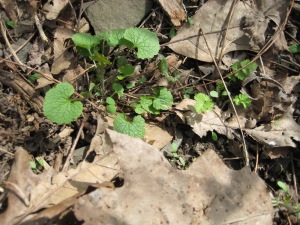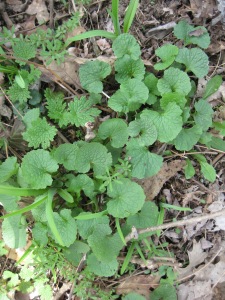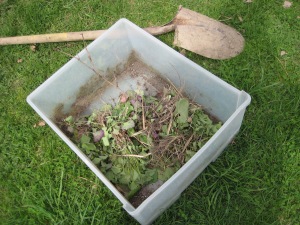Time to get rid of it. Garlic mustard. Out it goes!
The name sounds tasty, doesn’t it?  It’s a pretty little wildflower with lovely white blossoms. The leaves have an attractively scalloped edge, and a savory garlic taste, a fantastic addition to salads, quiche, and stir-fry. A lovely and useful plant, you’d think.
It’s a pretty little wildflower with lovely white blossoms. The leaves have an attractively scalloped edge, and a savory garlic taste, a fantastic addition to salads, quiche, and stir-fry. A lovely and useful plant, you’d think.
But I’ve spent all day killing it.
Eradicating it. Ripping it out by the roots. Doing everything short of spraying a dose of Round-Up on it.
Why? I have an enormous tolerance for non-native “weeds,” as my undying love for dandelions shows. Why enjoy the dandelions, the clover, the daisies, and murder the poor little garlic mustard?
Two words. Shade tolerant.
Garlic mustard is able to grow in shade. And shade is the barrier most non-native plants won’t cross. Most non-native plants don’t pose a threat to wilderness areas. Tulips, petunias, peonies—they’re none of them native American plants, but they stay where they’re put. Even the hardy non-native “weeds” like dandelions, clovers, daisies, daylilies, Queen Anne’s lace—they all tend to stick to the open–they linger in the parking lot like timid urbanites, and don’t venture onto the back-country trails. Oh, some hardy individuals might venture a few yards into the forest, or pop up where a storm has toppled an old tree, opening a skylight in the canopy of leaves. But they need sun and can’t survive shade.
Not so for garlic mustard. Doesn’t mind shade a bit. And that makes it a major threat to woodland wildflowers. It’s incredibly fast-growing and aggressive plant, the tender green leaves marching like storm troopers across disturbed soil, choking out native plants—bloodroots, pink lady’s-slippers, anemones, hepatica, trillium, spring beauties, ferns, club moss…
And garlic mustard is ripening now, getting ready to go to seed. Garlic mustard is a biennial—first year: just leaves. Second year: leaves and a flower head. And those pretty little white flowers can produce hundreds and hundreds of seeds.
So now’s the time. Grab them before they seed. Pull’em up, yank’em out.
It’s easy to confuse them with violets, which look similar before they bloom. Garlic mustard smells distinctly like garlicgarlicgarlic. You can’t miss it. (Violets on the left in photo below, garlic mustard on the right.
And—here’s the really amazing part. Even after the plant is completely uprooted and thrown on the compost pile, the flowers can continue producing seed. Almost frightening, isn’t it? Uprooted, limp and dead-looking, yet they go on developing–living after death, like little green zombies. It took me a few years to figure out why the garlic mustard grew so prolifically around the compost pile…
So, sadly, you can’t recycle piles of uprooted garlic mustard, or do anything “green” with them. Into the trash, off to the landfill.
I hate this. I just hate this. I hate having to uproot anything in this season when we should nurture and rejoice in all plants. But something has to be weeded out of my yard; and it’ll be the garlic mustard.





Went for a walk in our local nature center last week & found out about this. Thanks for the tips about disposal– very useful!
I’m running out of garbage bags. There’s JUST SO MUCH of it.
This is a very invasive species. Pick some where it is already growing but do not plant it in your yard.
Absolutely! I couldn’t agree more.